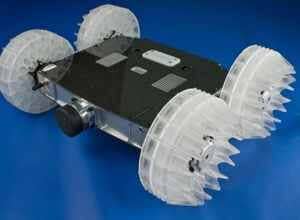New Video Of Sand Flea Robot Leaping (Onto) Tall Buildings 30ft High

Share
It doesn’t look like much, kind of a simple RC car. That is, until it jumps.
Boston Dynamics just released a video of their Sand Flea robot, and man can it jump. It rolls around, then stops, rears back on its hind wheels, and springs over walls and onto roofs – up to 30 feet high! It’s jumping is accurate enough that it can even leap into a second story window. You wanna scare the neighbors?
A CO2-powered piston gives the 11 pound Sand Flea its jumping power. Boston Dynamics hopes the little jumper will improve surveillance capabilities of soldiers on the battlefield. You’ll notice in the video below that the Sand Flea does a pretty good job landing flat on its four wheels. That’s not only for stability control, but to get the best possible video feed from an onboard camera. It won’t provide useful surveillance if its spinning end over end. A gyro stabilizer helps it to keep level during flight.
If you’ve seen Alpha Dog, you know that Boston Dynamics is good at building some sturdy robots. Sand Flea can perform about 25 jumps per charging. At 30 feet a leap, that’s a lot of abuse, but it’s going to need to be sturdy on the battlefield. Funded in part by the Army’s Rapid Equipping Force, nine Sand Fleas are destined for testing in Afghanistan.
Be Part of the Future
Sign up to receive top stories about groundbreaking technologies and visionary thinkers from SingularityHub.


Whether on land or in the air, robots continue to increase their numbers on the battlefield. With their load-bearing Alpha Dog and chemical suit-testing Petman, Boston Dynamics is certainly doing their part. The robotization of warfare is sure to continue, whether it be a steady march upward, or by leaps and bounds.
[image credit: Boston Dynamics]
[video credit: Boston Dynamics via YouTube]
images: Sand Flea
video: Sand Flea
Peter Murray was born in Boston in 1973. He earned a PhD in neuroscience at the University of Maryland, Baltimore studying gene expression in the neocortex. Following his dissertation work he spent three years as a post-doctoral fellow at the same university studying brain mechanisms of pain and motor control. He completed a collection of short stories in 2010 and has been writing for Singularity Hub since March 2011.
Related Articles

This Light-Powered AI Chip Is 100x Faster Than a Top Nvidia GPU

These Robots Are the Size of Single Cells and Cost Just a Penny Apiece

Hugging Face Says AI Models With Reasoning Use 30x More Energy on Average
What we’re reading
